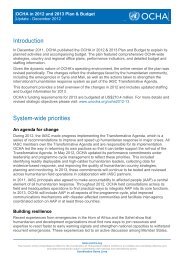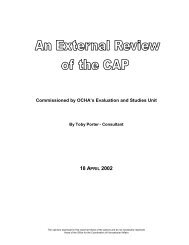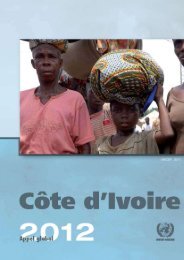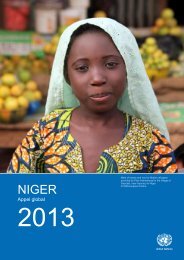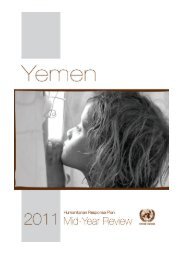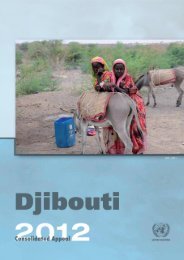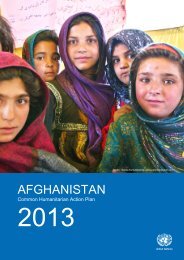Table of contents
Untitled
Untitled
You also want an ePaper? Increase the reach of your titles
YUMPU automatically turns print PDFs into web optimized ePapers that Google loves.
United Nations and Partners[2] PROGRESS | sector responseMID YEAR REVIEW | Sudan work plan 201229<strong>Table</strong> <strong>of</strong> mid-year monitoring vs. objectivesOutcomes (withcorresponding targets)Outputs (with corresponding targets)Indicators (with correspondingtargets and baseline)Achieved as mid-yearStatusObjective 1: Improve the overall operating environment for humanitarian through advocacy and strengthened coordination.1. Strengthened coordinationmechanisms, responses andpreparedness for humanitarianand recovery action.2. Strengthened informationmanagement.1. Regular interactions amongst actors withstrong engagement on humanitarian and recoveryissues. (Government, UN, NGOs, donors,Red Crescent etc.).2. Increased data and information collection anddissemination, including SADD3. Supporting the development <strong>of</strong> common policiesand positions regarding durable solutions(in conjunction with return and reintegrationsector), improving the quality <strong>of</strong> needs assessments,gender mainstreaming and reinforcingcoordination mechanisms.75% <strong>of</strong> functional coordinationmechanisms in place: HumanitarianCoordniation Team (HCT), Inter-Sector Coordinators Group (ISCG),Joint Verification Mechanism (JVM).75% <strong>of</strong> information managementproducts timely produced anddisseminated (reports, maps, andminutes).11 HCT, three ad hocHCT, and five ISCGmeetings.15 logistics support mapsproduced 12 communityleaders meetings and168 community committeesmeetings in Zamzamcamp.On TrackObjective 2: Improve the efficiency <strong>of</strong> humanitarian programmes by providing common services that reduce indirect costs through economies <strong>of</strong> scale, increasedaccess to humanitarian pooled funding, common transport services, expansion <strong>of</strong> mapping services and provision <strong>of</strong> security support and advice.1. Increased rate <strong>of</strong> utilization<strong>of</strong> common services forhumanitarian action.1. Safe and efficient air transport provided thatimprove access to and delivery <strong>of</strong> assistance toaffected population.2. Increased access to security services andsupport.3. Timely allocations made to the most urgentneeds and critical gaps.Number <strong>of</strong> passengers, agencies,tonnage <strong>of</strong> cargo transported, anddestinations reached.100 % coverage for security training,assessments, evacuations,reports, and maps meeting userrequirements.Security communicationsservices: very high frequency /high frequency (VHF/HF) radiobackbone, 24/7 operational radiochecks, technical support) insupport <strong>of</strong> staff safety and security,provided in all 15 approved interagencylocations.Total cargo transported56,821 Kg.Total passengers transported7,1801200 students beenrelocated to El Fasher tosit for basic educationexamination fromZamzam IDPs camp.Dissemination <strong>of</strong> SituationReports – daily, 100%coverage.One week security trainingfor INGO in deepfield (in situ).One relocation for INGOstaff.SevenMORSS/MOSSassessments and ninesecurity assessmentmissions.On TrackObjective 3: Build capacity <strong>of</strong> national and international actors to respond effectively and efficiently to existing and unforeseen humanitarian needs.1. Enhanced local partners’capacities to lead humanitarianand recovery responses.1. Improved partnership and coordinationamongst and with national partners.2. Increased number <strong>of</strong> Government andnational actors involved in humanitarian work.Number <strong>of</strong> training conductedand people trained disaggregatedby sex.Number <strong>of</strong> local partners involvedin humanitarian and recoveryactivities.Global PositioningSystem (GPS) trainingfor 22 national NGO’smembers in Darfur Statesand Khartoum.185 teachers beentrained from the ministry<strong>of</strong> education in teachingskills.On TrackA Coordination Committee between HAC and the UN wasdecreed by the Minister <strong>of</strong> Welfare and Social Insurance inMarch 2012.Implementation ChallengesThe two major challenges encountered by the sector arehumanitarian access and funding constraints. Partners facedrestrictions on access to affected areas and beneficiariesin South Kord<strong>of</strong>an, Blue Nile and in some parts <strong>of</strong> Darfur,particu¬larly the areas under the control <strong>of</strong> armed oppositionmove¬ments. Limited funding has greatly affected sector partners’operations and activities, affecting progress towards the2012 HWP targets and objectives . UNHAS’s financial situationmay become critical by the end <strong>of</strong> June as they will have usedall received funding and may be forced to scale back operations,which would affect many humanitarian organizations..In terms <strong>of</strong> funding, delays in donor dispersal <strong>of</strong> CHF fundinghave held back activities <strong>of</strong> most partners, including therecruitment <strong>of</strong> a UNDSS INGO Liaison Officer for North Darfur.Changes in TargetsNo changes in targets reported.Sector Project RevalidationSector coordination meetings, including national partners,were held to exchange information to avoid any duplicationand ensure coverage to the extent possible . Further, projectshave been re-prioritized with only 38% <strong>of</strong> projects ranked ashigh priority to ensure funding for the highest priority activities.




